Friction Durability of Extremely Thin Diamond-Like Carbon Films at High Temperature
Abstract
:1. Introduction
2. Materials and Methods
2.1. Evaluated Diamond-Like Carbon Films
2.2. Load Increase-and-Decrease Type Friction Test
2.3. Nano-Friction Test
3. Experimental Results and Discussion
3.1. Macroscopic Tribological Properties at High Temperature Evaluated by Load Increase-and-Decrease Type Friction Test
3.1.1. Dependence of Friction Properties on Reciprocating Cycle Number and Applied Load
3.1.2. Evaluation of Durability by Cluster Analysis of the Friction Coefficient
3.1.3. Dependence of Durability on Film Thickness and Surface Temperature
3.2. Mechanism of Durability Change at High Temperature
3.2.1. Friction Durability at Room Temperature after High Temperature Heating
3.2.2. Evaluation of Mechanism of Decrease and Increase in Durability of FCVA-DLC and P-CVD-DLC Films by Nano-Friction Test
3.2.2.1. Nano-friction Test with and after High Temperature Heating
3.2.2.2. Decrease in Friction Durability of FCVA-DLC Films at High Temperature
3.2.2.3. Increase in Durability of P-CVD-DLC Films at High Temperature
4. Conclusions
- (1)
- At room temperature, the durability of the FCVA-DLC films was superior to that of the P-CVD-DLC films. However, at high temperatures, the friction durability of the sub-2-nm-thick FCVA-DLC films decreased. The lubricating effect of the FCVA-DLC films was lost after fewer sliding cycles at high temperatures. The durability of the P-CVD-DLC films increased at high temperatures, when compared to that measured at room temperature. The durability of the P-CVD-DLC films increased at a certain temperature.
- (2)
- The dependence of the friction coefficient on the load and number of reciprocating cycles at different temperatures, were evaluated by statistical cluster analysis. The dependence was classified into two clusters; cluster-I represented a low friction region in which the DLC film was effective, and cluster-II represented a high friction region where the lubricating effect of the DLC film was lost. The friction durability cycle and load could be evaluated from the boundary conditions of these clusters.
- (3)
- The friction coefficient of the FCVA-DLC film was stable and low at room temperature, after heating at less than 300 °C. The decrease in the durability of the FCVA-DLC film at high temperatures, likely originated from a combination of the degradation of the film at high temperature, and the complex action of friction and high temperature. The increase in the friction coefficient of the FCVA-DLC film at high temperatures, was attributed to the removal of the lubricous adsorbate on its surface during sliding at high temperatures. The hard and brittle FCVA-DLC film then fractured, and hard wear debris enhanced the damage of the film and increased its friction, similar to that observed during the nanowear tests.
- (4)
- The durability of the P-CVD-DLC film after heating was considerably lower than that of the FCVA-DLC film. However, the friction coefficient of the P-CVD-DLC films tended to stay low for more durability test cycles at high temperatures. This effect of the P-CVD-DLC film at high temperatures likely originated from the lubricous layer produced by the tribochemical reactions of the hydrogen-containing P-CVD-DLC film at high temperatures. This lubricous layer enhanced the durability of the P-CVD-DLC film.
- (5)
- In our nano-friction tests, the friction coefficient dependence on temperature for FCVA-DLC and P-CVD-DLC films, showed opposing tendencies. The friction force measured for the FCVA-DLC film after heating was low. In contrast, the friction force increased at high temperatures. Conversely, the friction force measured for the P-CVD-DLC film after heating was relatively high, while that measured at high temperatures was low and stable. This reversed temperature dependence of the FCVA-DLC and P-CVD-DLC films was similar to that observed during the macroscopic friction tests. These results contribute to the understanding of how durability depends on temperature in these systems.
Acknowledgments
Author Contributions
Conflicts of Interest
References
- Bhushan, B. Tribology and Mechanics of Magnetic Storage Devices; Springer: New York, NY, USA, 1990. [Google Scholar]
- Miyake, S.; Wang, M. Nanotribology of Magnetic Disks, Encyclopedia of Nanoscience and Nanotechnology; American Scientific Publishers: Valencia, CA, USA, 2013; Chapter-56; pp. 1–52. [Google Scholar]
- Miyake, S.; Kaneko, R. Microtribological properties and potential applications of hard, lubricating coatings. Thin Solid Films 1992, 212, 256–261. [Google Scholar] [CrossRef]
- Miyake, S.; Wakatsuki, Y.; Wang, M.; Matsunuma, S. Amplitude dependence of the lateral-vibration wear test for perpendicular recording magnetic disks treated by heat curing. Jpn. J. Appl. Phys. 2005, 44, 3209–3217. [Google Scholar] [CrossRef]
- Miyake, S.; Wang, M.; Saitoh, T.; Watanabe, S. Microtribological properties of B-C-N extremely thin protective films deposited on plasma pretreated magnetic layers. Surf. Coat. Technol. 2005, 195, 214–226. [Google Scholar] [CrossRef]
- Yasui, N.; Inaba, H.; Furusawa, K. Characterization of head overcoat for 1 Tb/in2 magnetic recording. IEEE Magn. Soc. 2009, 45, 805–809. [Google Scholar] [CrossRef]
- Marchon, B.; Pitchford, T.; Hsia, Y.T.; Gangopadhyay, S. The head-disk interface roadmap to an areal density of Tbit/in2. Adv. Tribol. 2013, 2013, 521086. [Google Scholar] [CrossRef]
- Katayama, H.; Sawamura, S.; Ogimoto, Y.; Nakajima, J.; Kojima, K.; Ohta, K. New magnetic recording method using laser assisteread/write technologies. J. Magn. Soc. Jpn. 1999, 23, 233–236. [Google Scholar] [CrossRef]
- Saga, H.; Nemoto, H.; Sukeda, H.; Takahashi, M. New recording method combining thermo-magnetic writing and flux detection. Jpn. J. Appl. Phys. 1999, 3B, 1839–1840. [Google Scholar] [CrossRef]
- Pathem, B.K.; Guo, X.C.; Rose, F.; Marchon, B. Carbon overcoat oxidation in heat-assisted magnetic recording. IEEE Trans. Magn. 2013, 49, 3721–3724. [Google Scholar] [CrossRef]
- Tagawa, N.; Tani, H. Structural stability of nanometer thick diamond-like carbon films subjected to heating for thermally assisted magnetic recording. Microsyst. Technol. 2014, 20, 1405–1411. [Google Scholar] [CrossRef]
- Wang, N.; Komvopoulos, K. Thermal stability of ultrathin amorphous carbon films for energy-assisted magnetic recording. IEEE Trans. Magn. 2011, 47, 2277–2282. [Google Scholar] [CrossRef]
- Yamamoto, T.; Toyoguchi, T.; Honda, F. Ultrathin amorphous C:H overcoats by pCVD on thin film media. IEEE Trans. Magn. 2000, 36, 115–119. [Google Scholar] [CrossRef]
- Robertson, J. Ultrathin carbon coatings for magnetic storage technology. Thin Solid Films 2001, 383, 81–88. [Google Scholar] [CrossRef]
- Yamamoto, T.; Hyodo, H.; Tsuchitani, S.; Kaneko, R. Ultrathin amorphous carbon overcoats by filtered cathodic arc deposition. IEEE Trans. Magn. 2003, 39, 2201–2204. [Google Scholar] [CrossRef]
- Hyodo, H.; Yamamoto, T.; Toyoguchi, T. Properties of tetrahedral amorphous carbon film by filtered cathodic arc deposition for disk overcoat. IEEE Trans. Magn. 2001, 37, 1789–1791. [Google Scholar] [CrossRef]
- Xu, S.; Tay, B.K.; Tan, H.S.; Zhong, L.; Tu, Y.Q.; Silva, S.R.P.; Milne, W.I. Properties of carbon ion deposited tetrahedral amorphous carbon films as a function of ion energy. J. Appl. Phys. 1996, 79, 7234–7240. [Google Scholar] [CrossRef]
- Lemoine, P.; Quinn, J.P.; Maguire, P.D.; Zhao, J.F.; McLaughlin, J.A. Intrinsic mechanical properties of extremely thin amorphous carbon layers. Appl. Surf. Sci. 2007, 253, 6165–6175. [Google Scholar] [CrossRef]
- Miyake, S.; Shindo, T.; Miyake, M. Regression analysis of the effect of bias voltage on nano- and macrotribological properties of diamond-like carbon films deposited by a filtered cathodic vacuum arc ion-plating method. J. Nanomater. 2014, 2014, 657619. [Google Scholar] [CrossRef]
- Miyake, S.; Kurosaka, W.; Oshimoto, K. Nanometer-scale mechanical properties of extremely thin diamondlike carbon films. Tribol. Mater. Surf. Interfaces 2009, 3, 158–164. [Google Scholar] [CrossRef]
- Miyake, S.; Yamazaki, S. Nanoscratch properties of extremely thin diamond-like carbon films. Wear 2013, 305, 69–77. [Google Scholar] [CrossRef]
- Miyake, S.; Yamazaki, S. Evaluation of protuberance and groove formation in extremely thin DLC films on Si substrates due to diamond tip sliding by atomic force microscopy. Wear 2014, 318, 135–144. [Google Scholar] [CrossRef]
- Miyake, S.; Kawasaki, S.; Yamazaki, S. Nanotribology properties of extremely thin diamond-like carbon films at high temperatures with and without vibration. Wear 2013, 300, 189–199. [Google Scholar] [CrossRef]
- Miyake, S.; Inagaki, J.; Miyake, M. Dependence of the friction durability of extremely thin diamond-like carbon films on film thickness. Wear 2016, 356–357, 66–76. [Google Scholar] [CrossRef]
- Beakea, B.D.; Daviesa, M.I.; Liskiewiczc, T.W.; Vishnyakovb, V.M.; Goodesa, S.R. Nano-scratch, nanoindentation and fretting tests of 5–80 nm ta-C films on Si (100). Wear 2013, 301, 575–582. [Google Scholar] [CrossRef]
- The R Project for Statistical Computing. Available online: https://www.r-project.org/ (accessed on 10 July 2015).
- Erdemir, A. The role of hydrogen in tribological properties of diamond-like carbon films. Surf. Coat. Technol. 2001, 146–147, 292–297. [Google Scholar] [CrossRef]
- Sugimoto, I.; Miyake, S. Oriented hydrocarbons transformed from a high performance lubricative amorphous C:H:Si film during sliding in a vacuum. Appl. Phys. Lett. 1990, 56, 1868–1870. [Google Scholar] [CrossRef]
- Miyake, S. Tribological properties of hard carbon films, extremely low friction mechanism of amorphous hydrogenated carbon films and amorphous hydrogenated SiC films in vacuum. Surf. Coat. Technol. 1993, 54–55, 563–569. [Google Scholar]
- Heimberg, J.A.; Wahl, K.J.; Singer, I.L.; Erdemir, A. Superlow friction behavior of diamond-like carbon coatings: Time and speed effects. Appl. Phys. Lett. 2001, 78. [Google Scholar] [CrossRef]
- Lancaster, J.K.; Pritchard, J.R. The influence of environment and pressure on the transition to dusting wear of graphite. J. Phys. D: Appl. Phys. 1981, 14, 747. [Google Scholar] [CrossRef]
- Miyake, S.; Takahashi, S.; Watanabe, I.; Yoshihara, H. Friction and wear behavior of hard carbon films. ASLE Trans. 1987, 30, 121–127. [Google Scholar] [CrossRef]
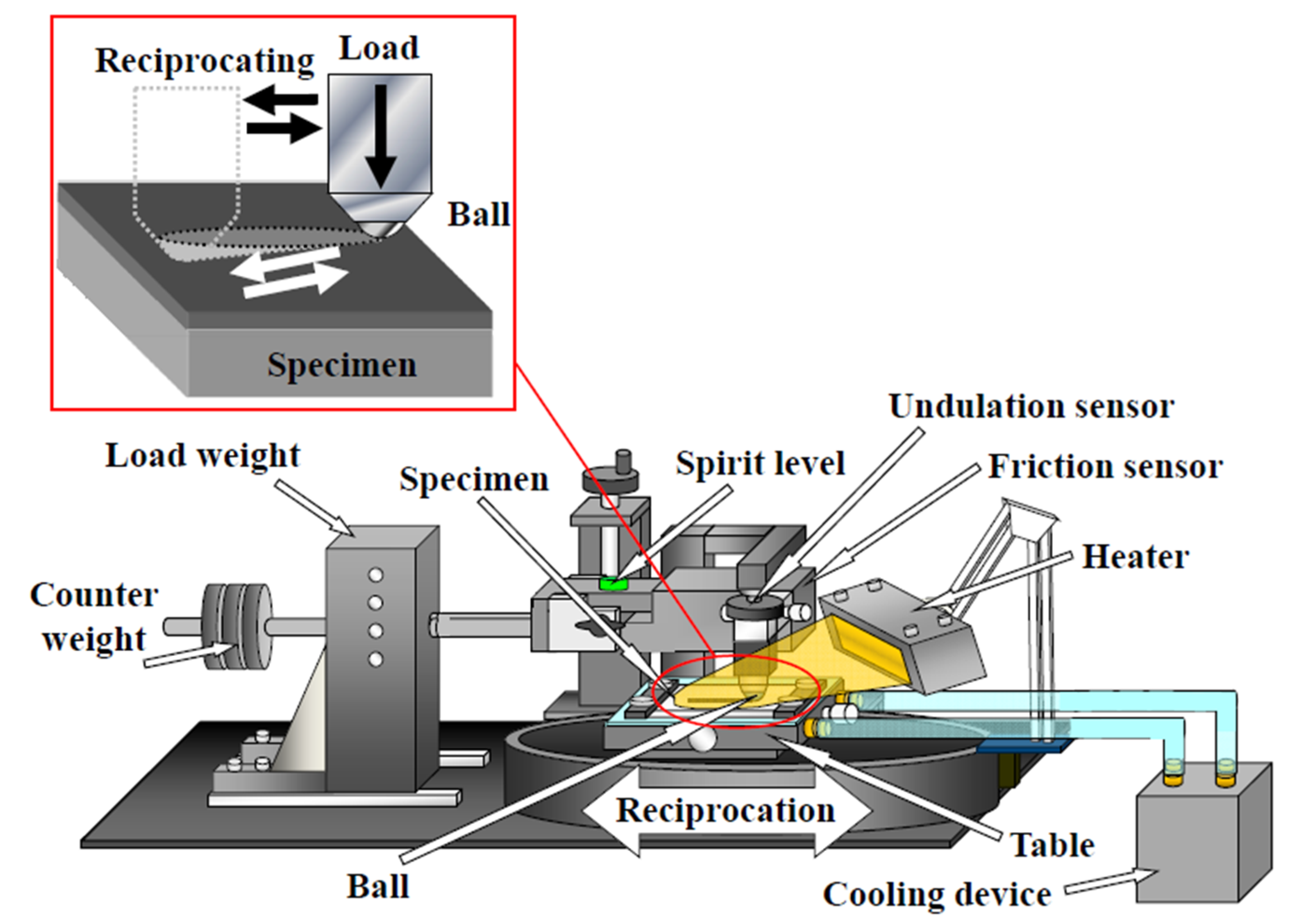
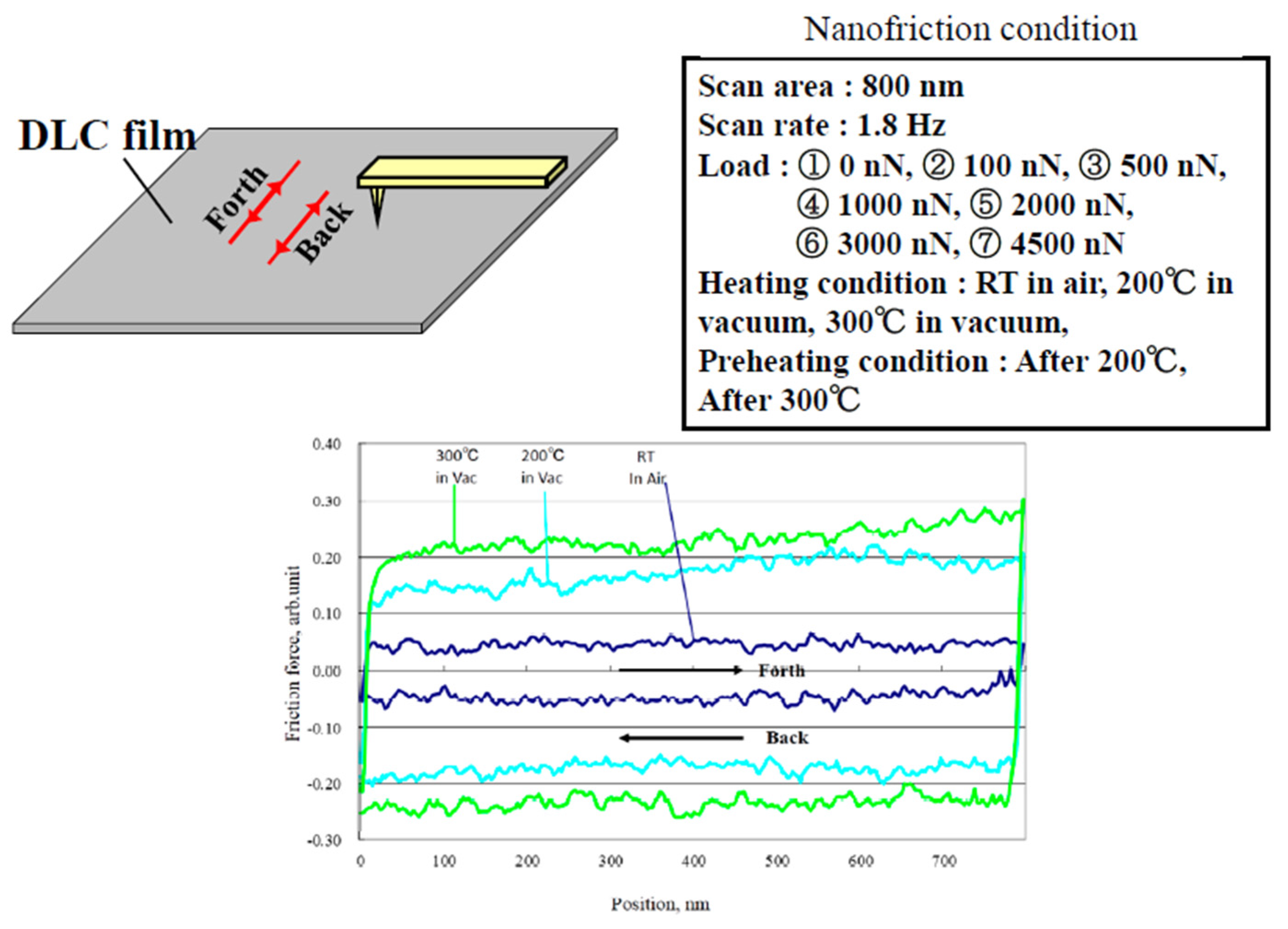
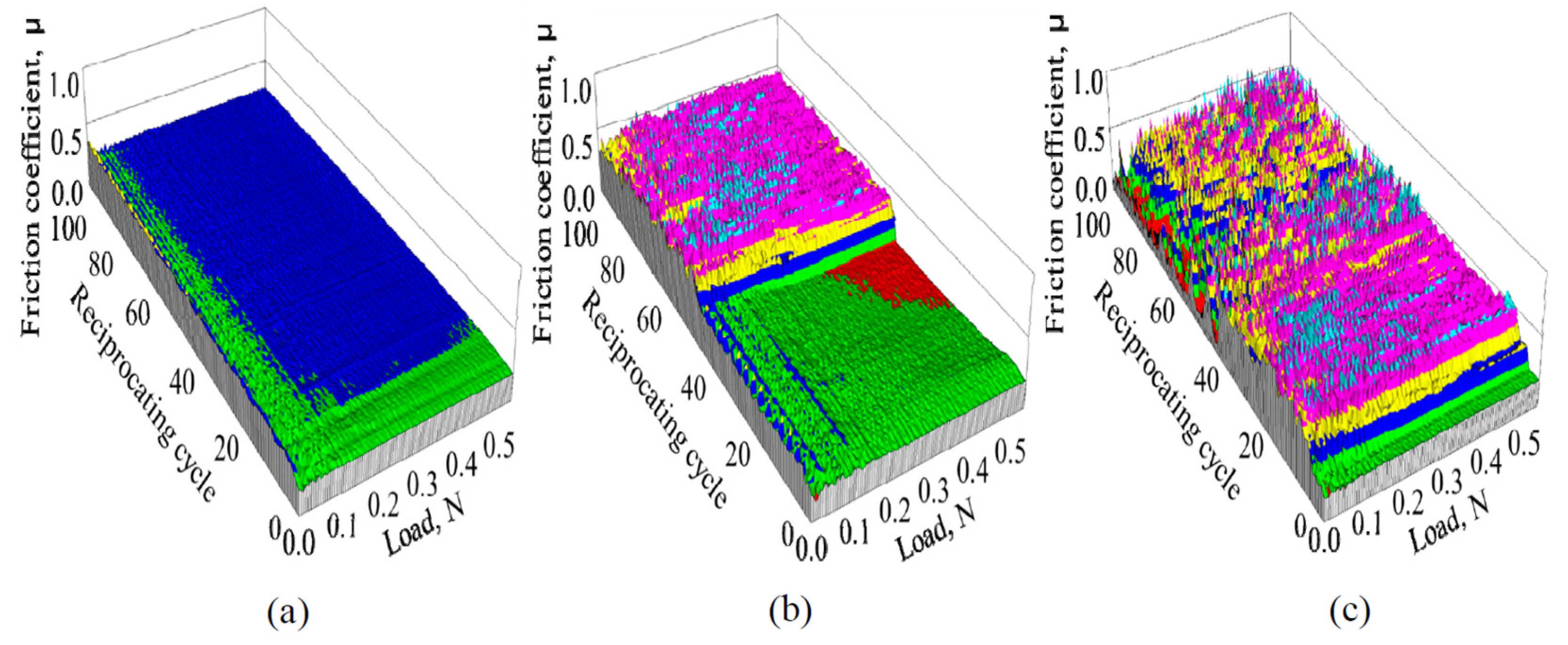

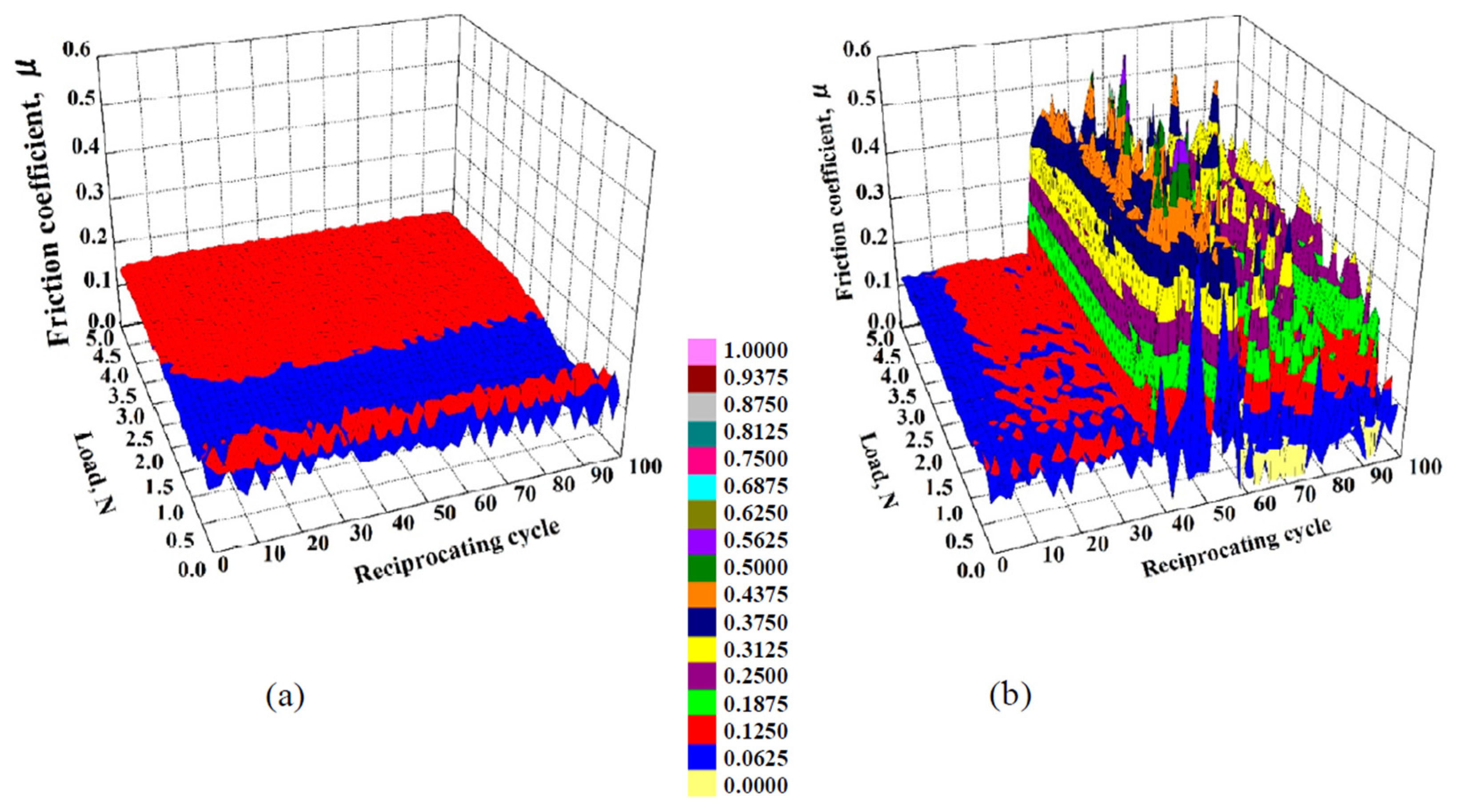
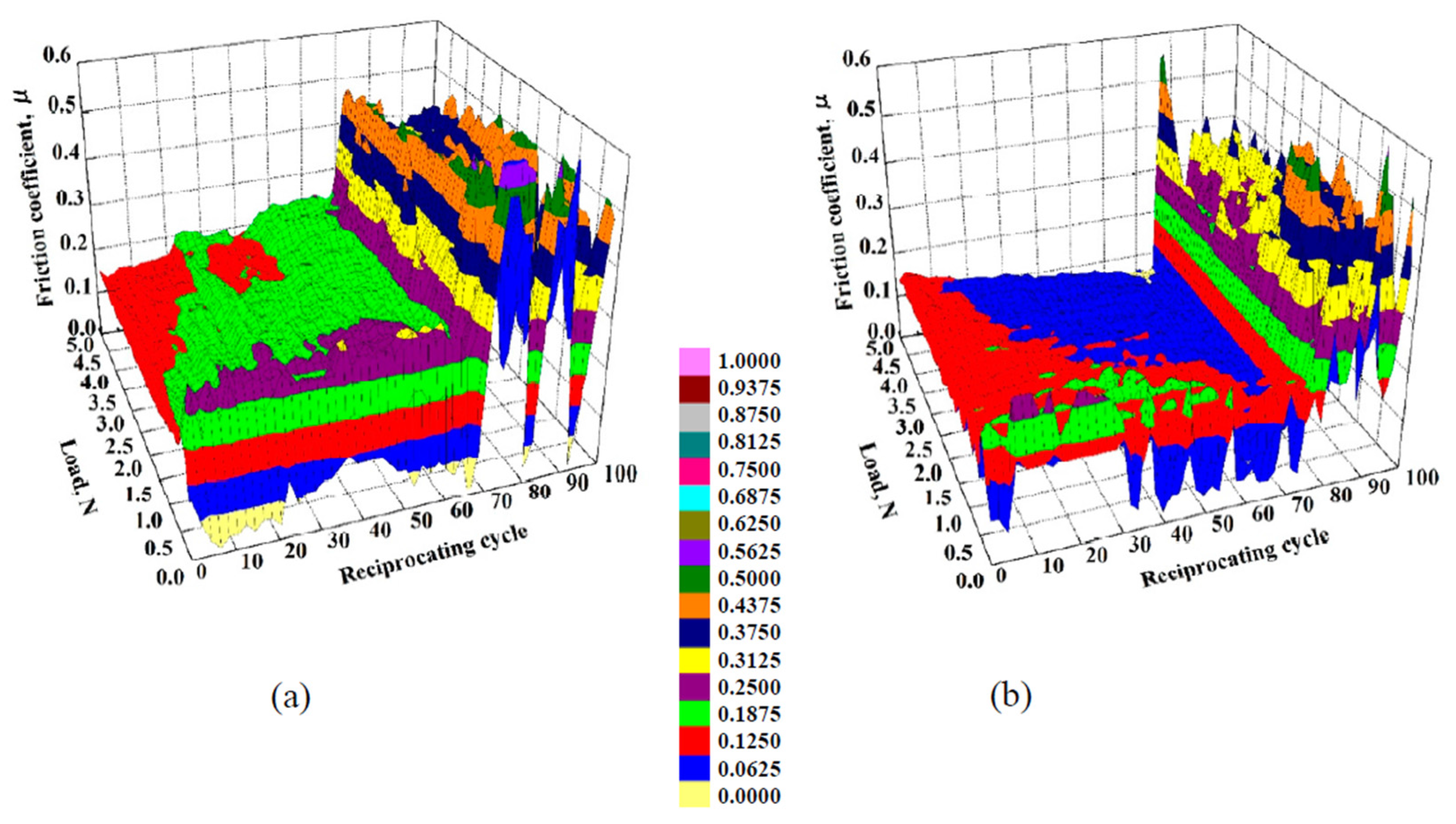
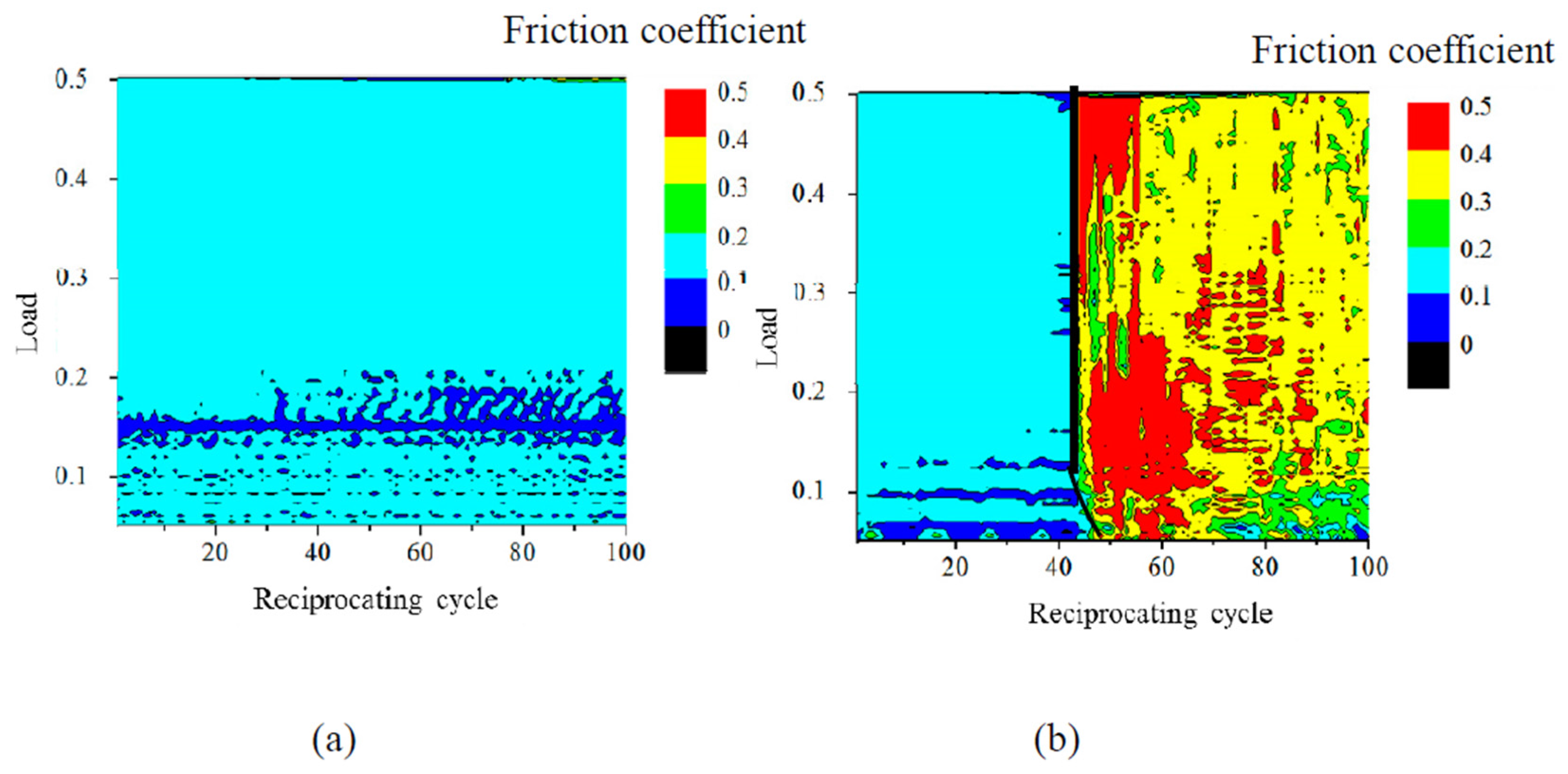

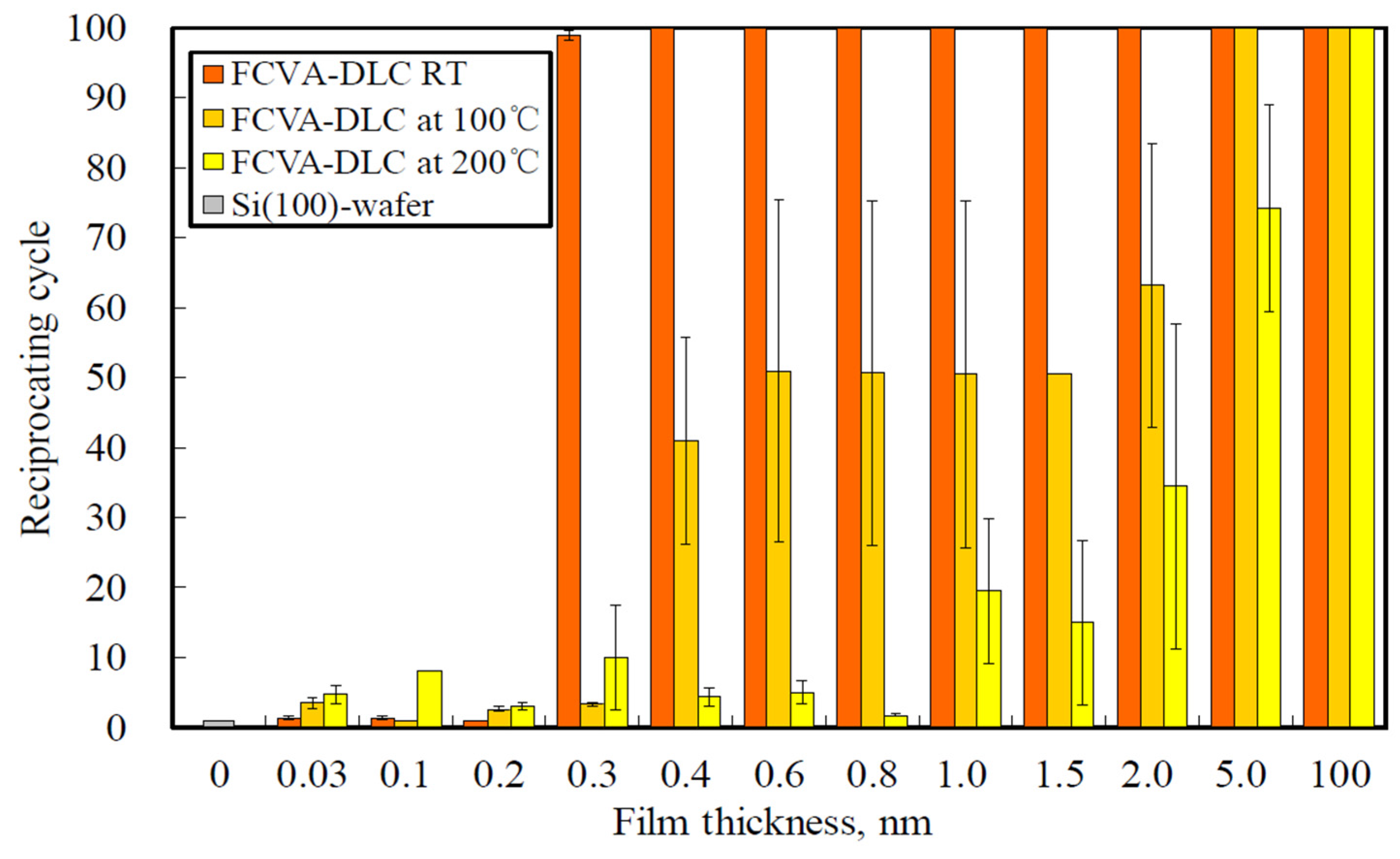
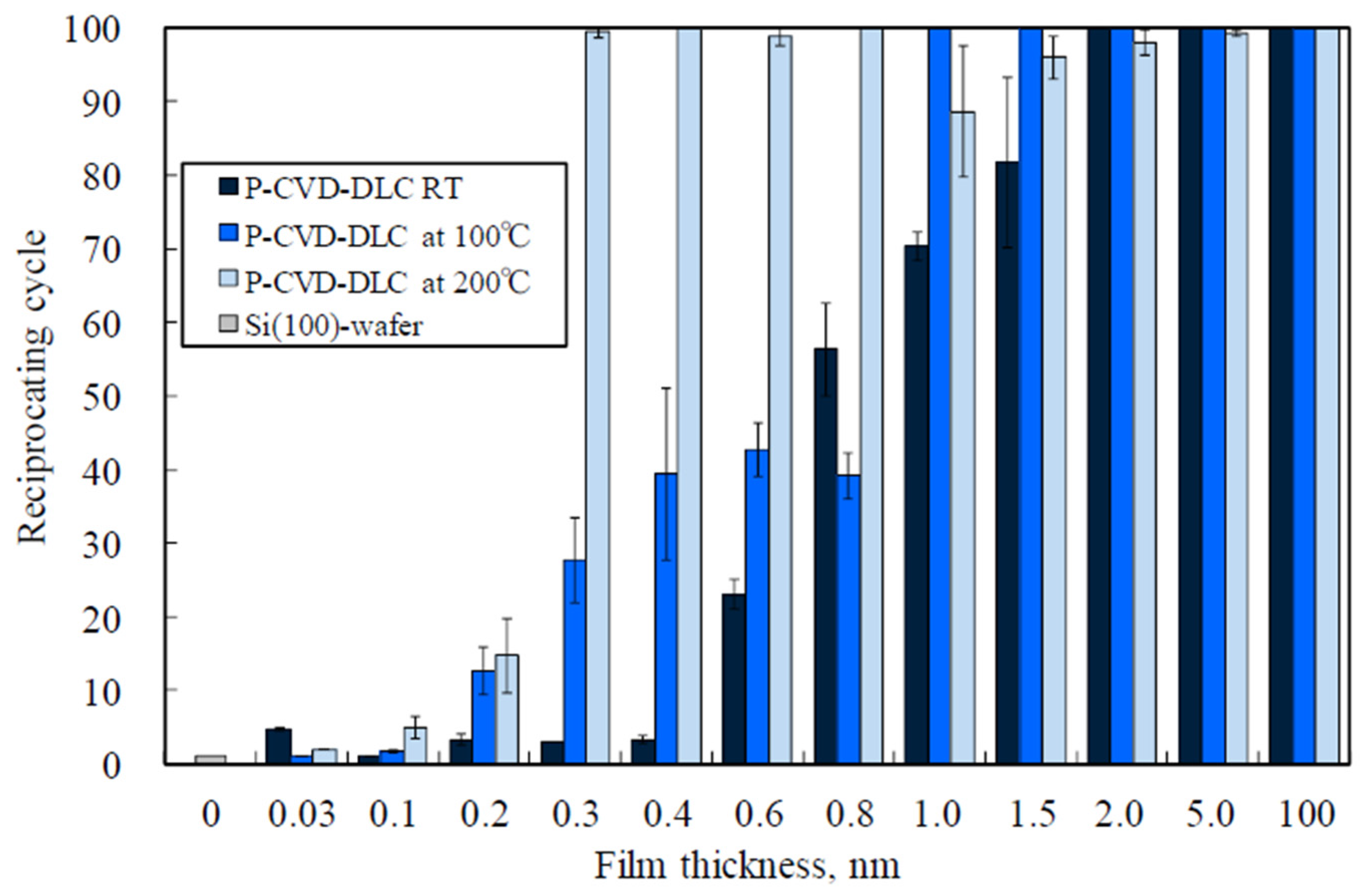
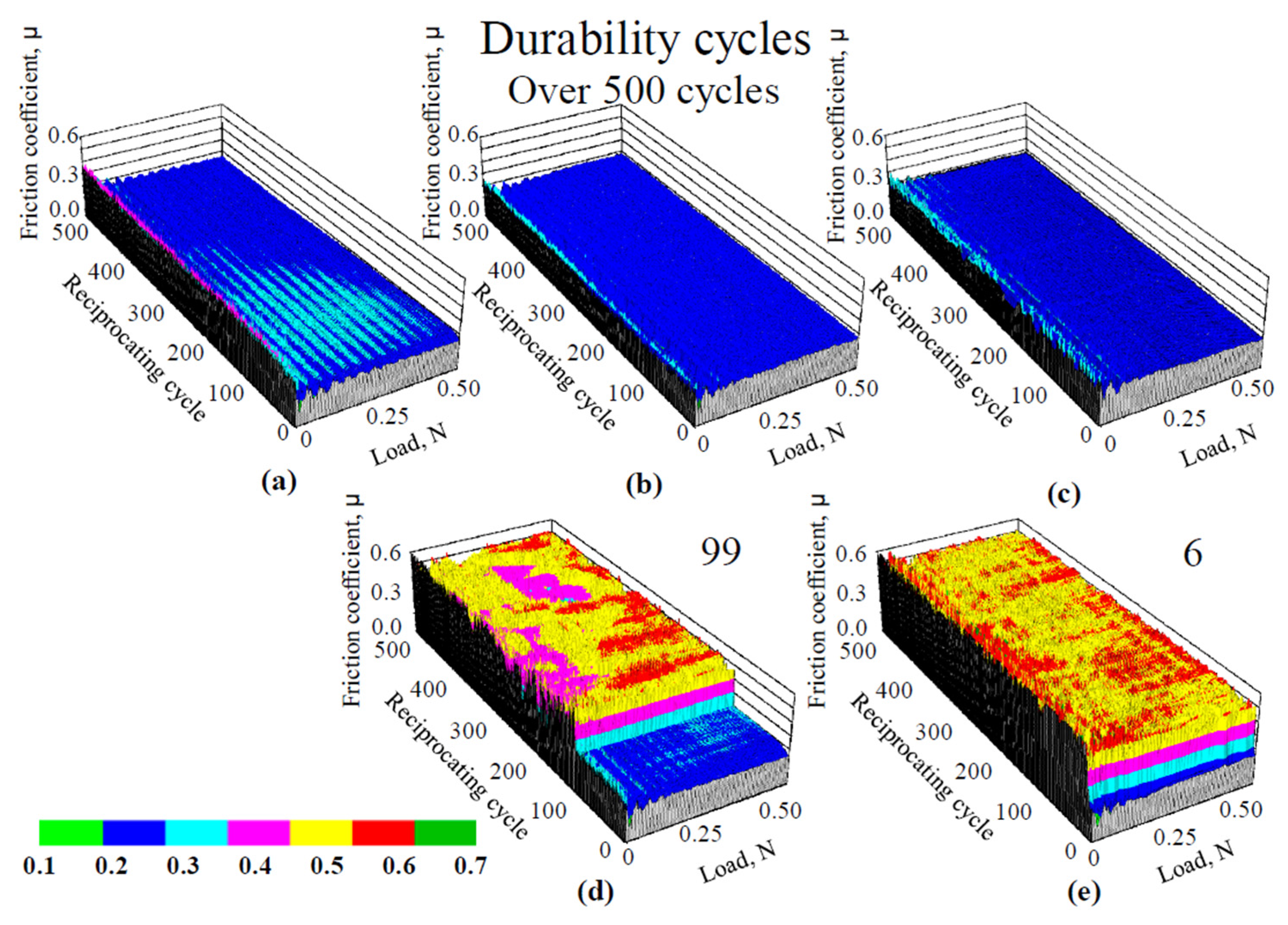
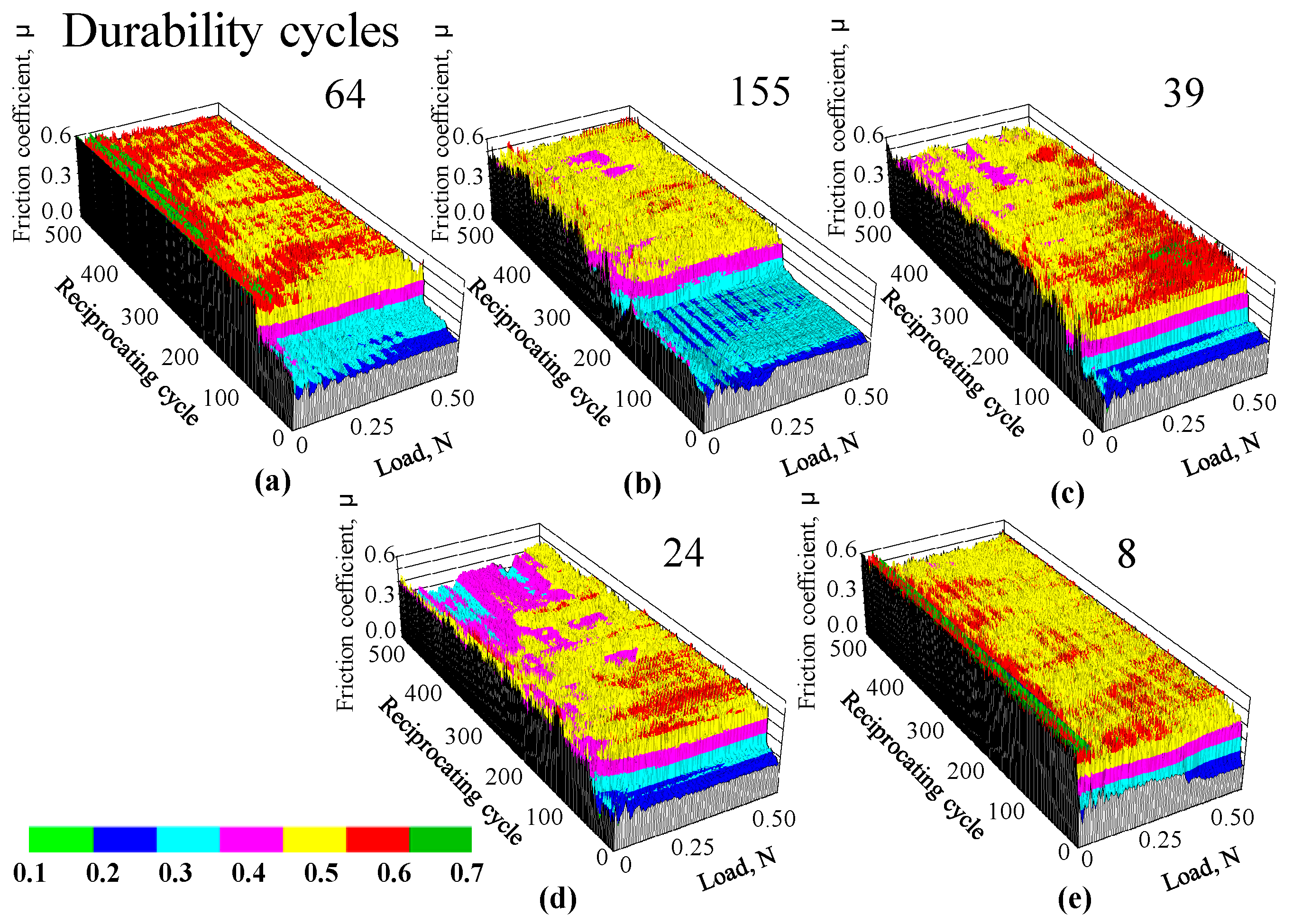
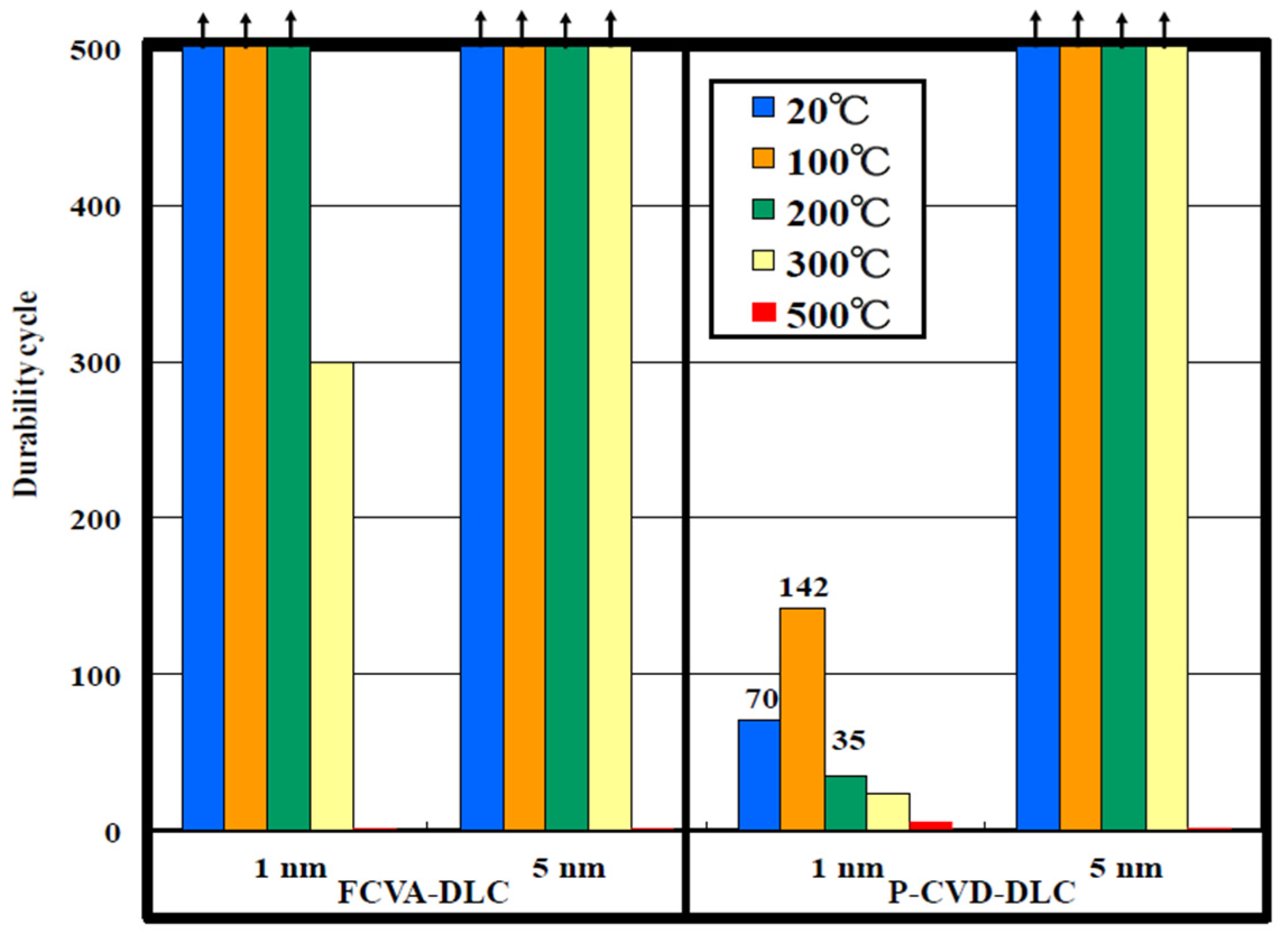
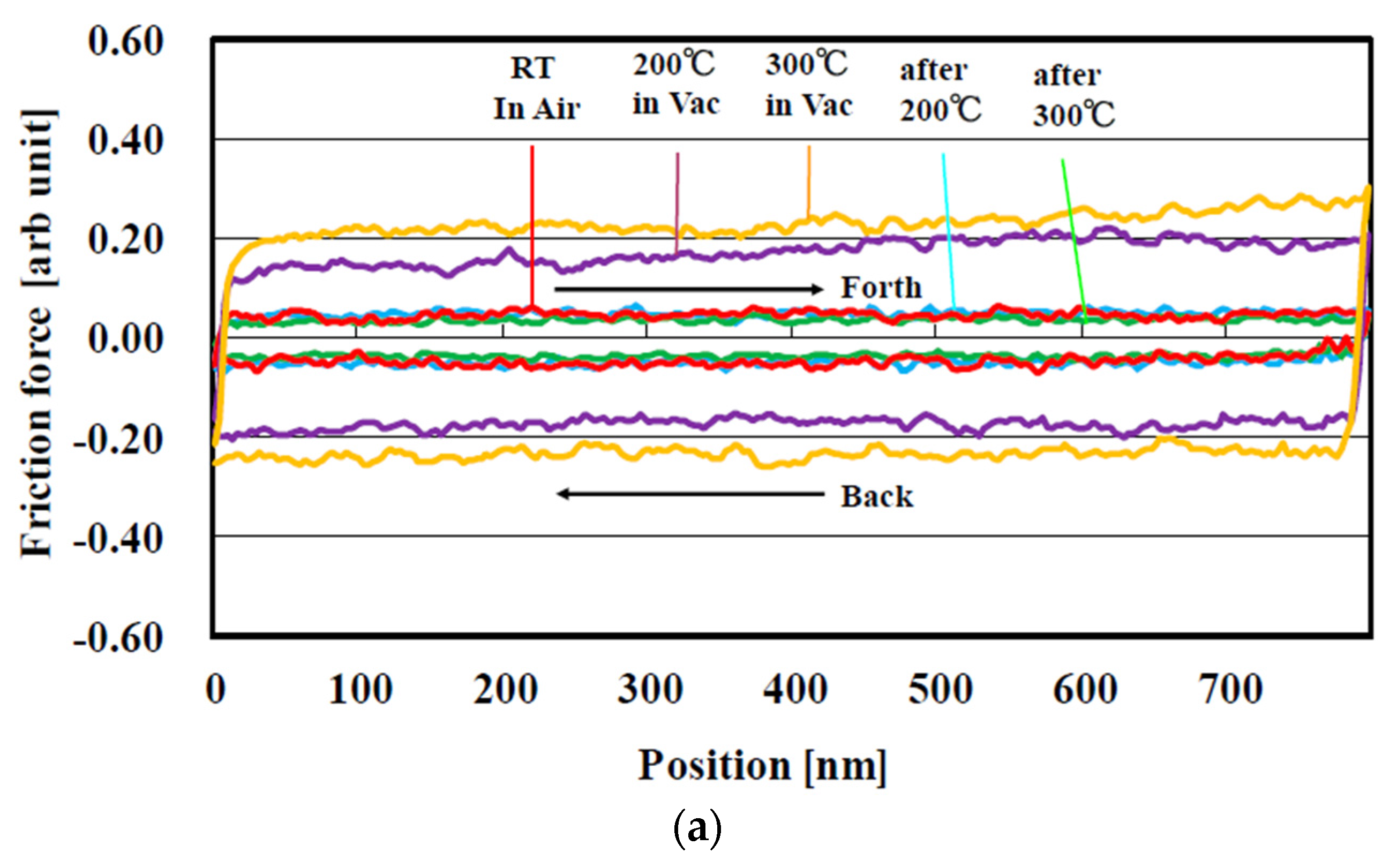
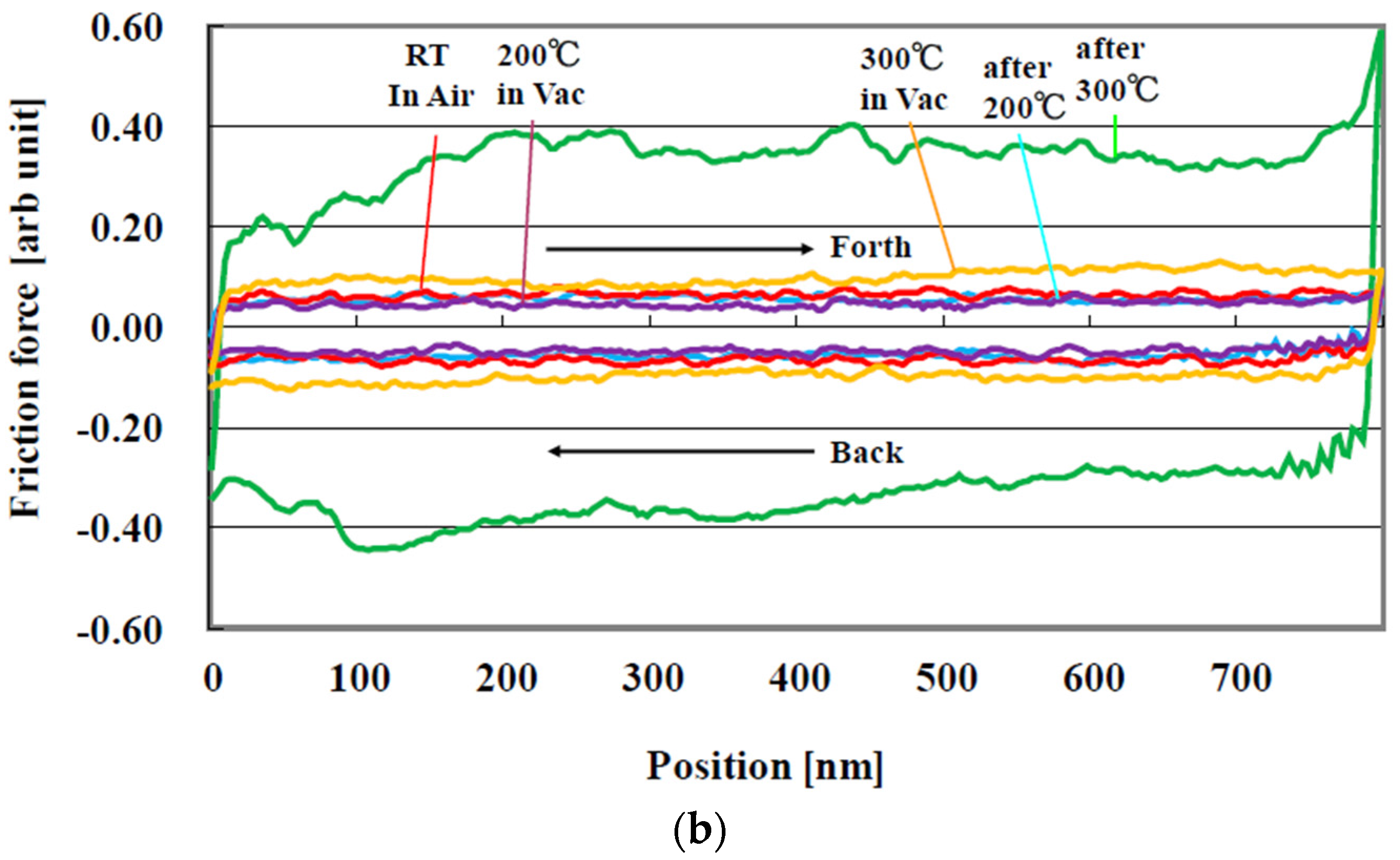
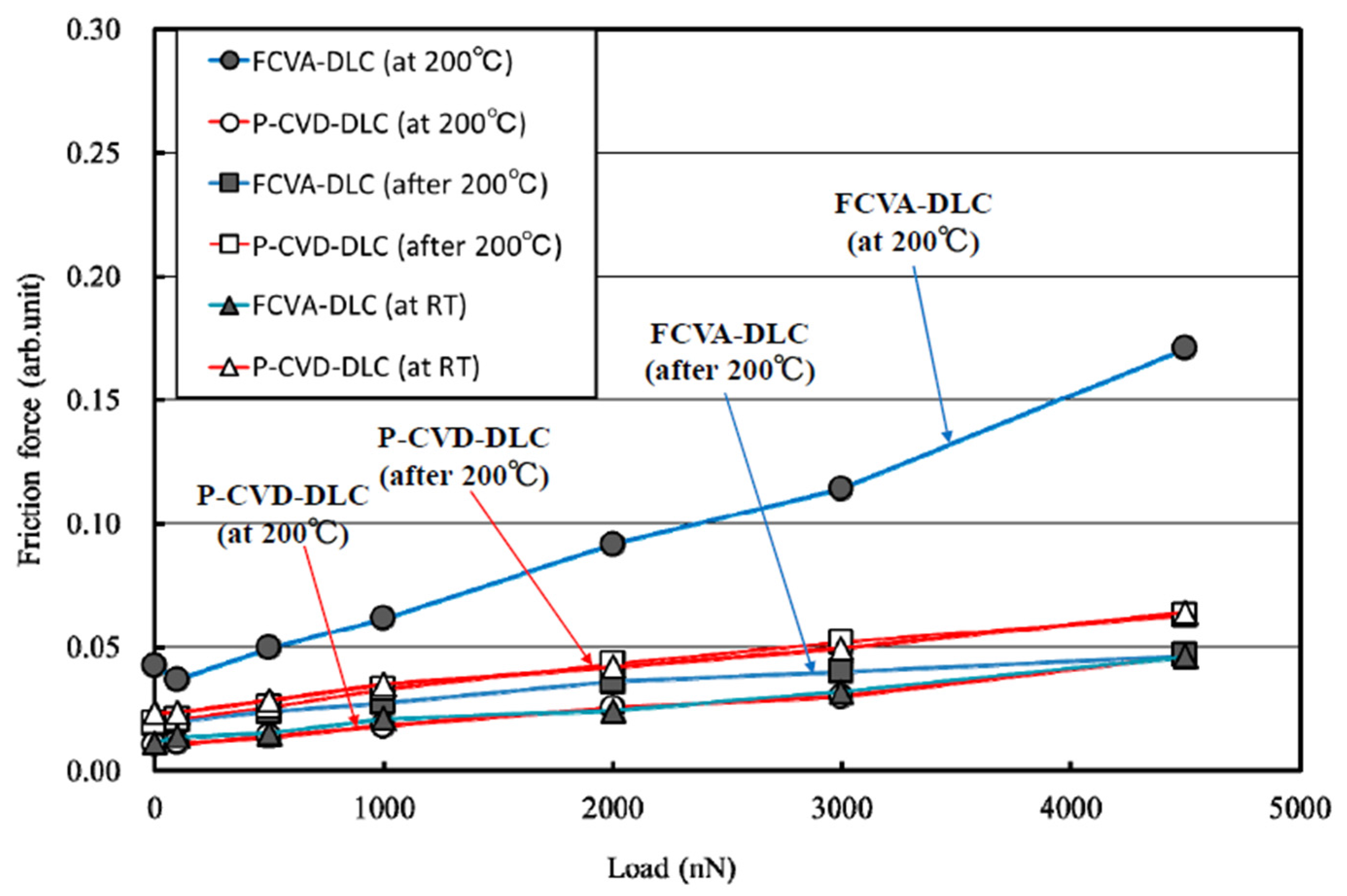
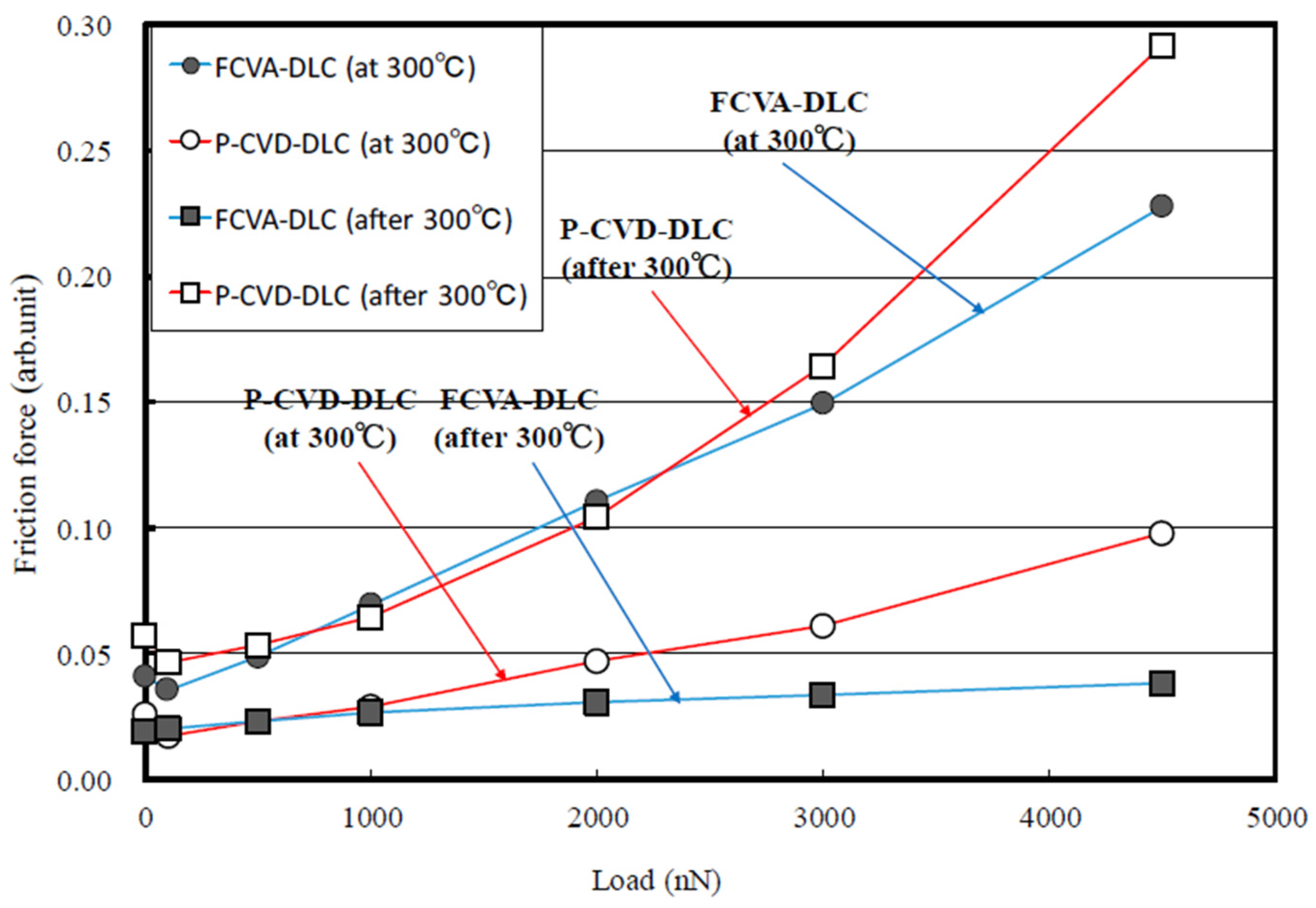
| Film | Average Friction Coefficient of Cluster-І | Average Friction Coefficient of Cluster- ІІ | Boundary Friction Coefficient |
|---|---|---|---|
| FCVA-DLC (RT) | 0.132 | --- | --- |
| FCVA-DLC (200 °C) | 0.127 | 0.38 | 0.25 |
| P-CVD-DLC (RT) | 0.214 | 0.43 | 0.32 |
| P-CVD-DLC (200 °C) | 0.129 | 0.34 | 0.24 |
© 2017 by the authors. Licensee MDPI, Basel, Switzerland. This article is an open access article distributed under the terms and conditions of the Creative Commons Attribution (CC BY) license ( http://creativecommons.org/licenses/by/4.0/).
Share and Cite
Miyake, S.; Suzuki, S.; Miyake, M. Friction Durability of Extremely Thin Diamond-Like Carbon Films at High Temperature. Materials 2017, 10, 159. https://doi.org/10.3390/ma10020159
Miyake S, Suzuki S, Miyake M. Friction Durability of Extremely Thin Diamond-Like Carbon Films at High Temperature. Materials. 2017; 10(2):159. https://doi.org/10.3390/ma10020159
Chicago/Turabian StyleMiyake, Shojiro, Shota Suzuki, and Masatoshi Miyake. 2017. "Friction Durability of Extremely Thin Diamond-Like Carbon Films at High Temperature" Materials 10, no. 2: 159. https://doi.org/10.3390/ma10020159




